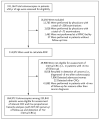Adenoma detection rate and risk of colorectal cancer and death
- PMID: 24693890
- PMCID: PMC4036494
- DOI: 10.1056/NEJMoa1309086
Adenoma detection rate and risk of colorectal cancer and death
Abstract
Background: The proportion of screening colonoscopic examinations performed by a physician that detect one or more adenomas (the adenoma detection rate) is a recommended quality measure. However, little is known about the association between this rate and patients' risks of a subsequent colorectal cancer (interval cancer) and death.
Methods: Using data from an integrated health care delivery organization, we evaluated the associations between the adenoma detection rate and the risks of colorectal cancer diagnosed 6 months to 10 years after colonoscopy and of cancer-related death. With the use of Cox regression, our estimates of attributable risk were adjusted for the demographic characteristics of the patients, indications for colonoscopy, and coexisting conditions.
Results: We evaluated 314,872 colonoscopies performed by 136 gastroenterologists; the adenoma detection rates ranged from 7.4 to 52.5%. During the follow-up period, we identified 712 interval colorectal adenocarcinomas, including 255 advanced-stage cancers, and 147 deaths from interval colorectal cancer. The unadjusted risks of interval cancer according to quintiles of adenoma detection rates, from lowest to highest, were 9.8, 8.6, 8.0, 7.0, and 4.8 cases per 10,000 person-years of follow-up, respectively. Among patients of physicians with adenoma detection rates in the highest quintile, as compared with patients of physicians with detection rates in the lowest quintile, the adjusted hazard ratio for any interval cancer was 0.52 (95% confidence interval [CI], 0.39 to 0.69), for advanced-stage interval cancer, 0.43 (95% CI, 0.29 to 0.64), and for fatal interval cancer, 0.38 (95% CI, 0.22 to 0.65). Each 1.0% increase in the adenoma detection rate was associated with a 3.0% decrease in the risk of cancer (hazard ratio, 0.97; 95% CI, 0.96 to 0.98).
Conclusions: The adenoma detection rate was inversely associated with the risks of interval colorectal cancer, advanced-stage interval cancer, and fatal interval cancer. (Funded by the Kaiser Permanente Community Benefit program and the National Cancer Institute.).
Figures


Comment in
-
Adenoma detection rate and risk of colorectal cancer and death.N Engl J Med. 2014 Jun 26;370(26):2541. doi: 10.1056/NEJMc1405329. N Engl J Med. 2014. PMID: 24963577 No abstract available.
-
Adenoma detection rate and risk of colorectal cancer and death.N Engl J Med. 2014 Jun 26;370(26):2539-40. doi: 10.1056/NEJMc1405329. N Engl J Med. 2014. PMID: 24963578 No abstract available.
-
Adenoma detection rate and risk of colorectal cancer and death.N Engl J Med. 2014 Jun 26;370(26):2540-1. doi: 10.1056/NEJMc1405329. N Engl J Med. 2014. PMID: 24963579 No abstract available.
-
"Actions speak louder than words": adenoma detection rates inversely associated with colorectal cancer and mortality.Turk J Gastroenterol. 2014 Oct;25(5):602. doi: 10.5152/tjg.2014.0050. Turk J Gastroenterol. 2014. PMID: 25417637 No abstract available.
References
-
- Lieberman DA, Rex DK, Winawer SJ, Giardiello FM, Johnson DA, Levin TR. Guidelines for colonoscopy surveillance after screening and polypectomy: a consensus update by the US Multi-Society Task Force on Colorectal Cancer. Gastroenterology. 2012;143:844–57. - PubMed
-
- Seeff LC, Richards TB, Shapiro JA, et al. How many endoscopies are performed for colorectal cancer screening? Results from CDC’s survey of endoscopic capacity. Gastroenterology. 2004;127:1670–7. - PubMed
-
- Siegel R, Naishadham D, Jemal A. Cancer statistics, 2013. CA Cancer J Clin. 2013;63:11–30. - PubMed
Publication types
MeSH terms
Grants and funding
LinkOut - more resources
Full Text Sources
Other Literature Sources
Medical
